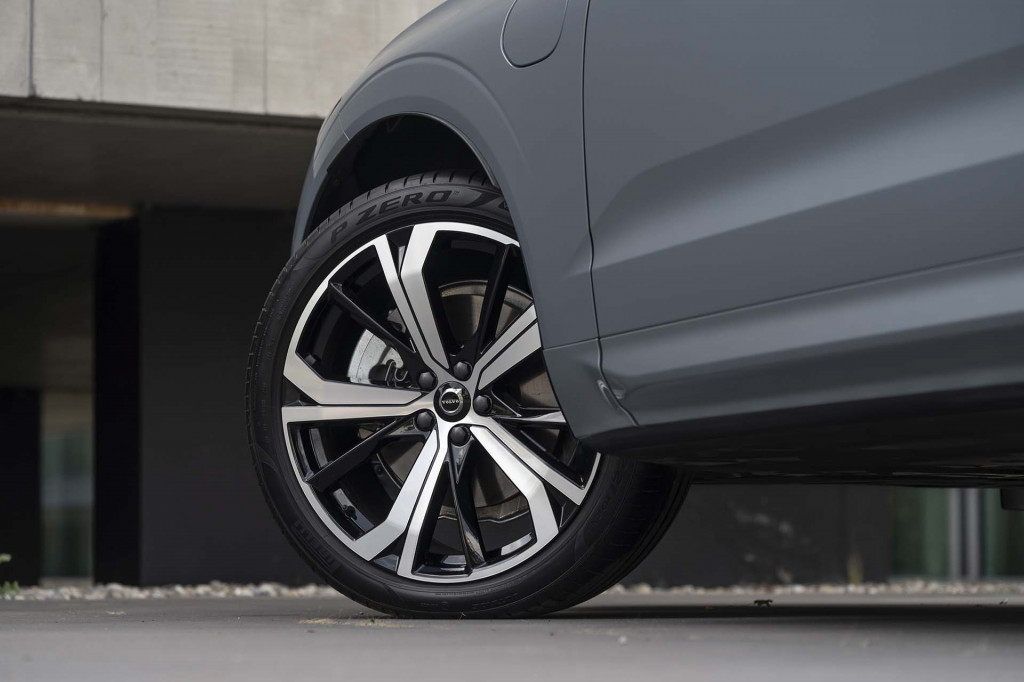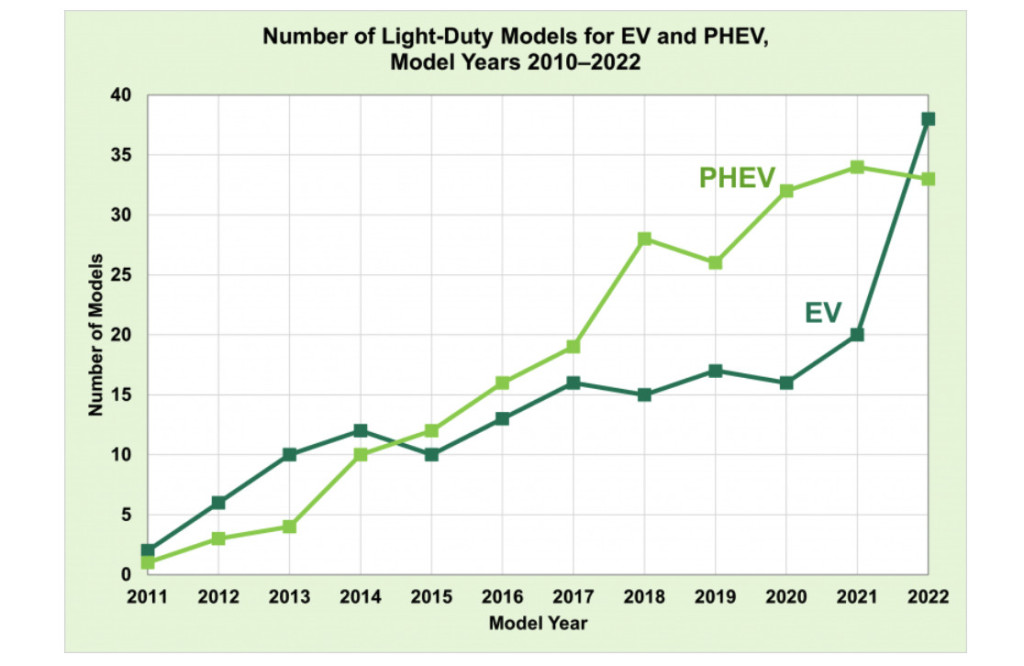Plug-in hybrid tech continues to be something that neither automakers nor regulators can completely agree on.
Some, like Toyota, Volvo, BMW, and others see them as a smart, effective bridge technology to EVs while others, including GM and Honda see them, at least for now in the U.S., as an unnecessary complication in the shift to EVs.
In light of proposed EPA vehicle pollution rules revealed earlier in the week, PHEVs aren’t going away. But as the U.S. Department of Energy recently highlighted, automakers aren’t increasing the number of PHEV choices.
Looking at light-duty vehicles, the DOE found that the number of EV models surpassed the number of plug-in hybrid models for the first time since 2014—going from 20 to 38 distinct models in just a year. And versus a year earlier, the number of PHEV models went down in 2022.
Number of EV and PHEV models – U.S. DOE
The DOE says that in calculating the number of models, it counted each model name just once, despite multiple configurations available for some of them.
By sales, EVs have been far ahead of PHEVs for some time—since around 2018. By the end of 2022, EVs stood at about 6% of the U.S. market while PHEVs were at just over 1%.
The EPA’s proposal for 2027-2032 vehicle emissions continues to emphasize plug-in hybrids, along with hydrogen fuel-cell vehicles, as part of alternative pathways for automakers to comply as part of a “technology-neutral” approach. California’s Advanced Clean Cars II (ACCII) rules that go into effect starting in 2026 will mandate the equivalent of 50 miles of real-world electric range in plug-in hybrids.
While automakers and regulators have pushed plug-in hybrids as part of the solution for stricter emissions standards, there’s longstanding controversy over the real-world effects of plug-in hybrids, and how much owners truly plug in. And beyond that, recent tests commissioned by the European environmental group Transport & Environment (T&E) found that some plug-in hybrids emitted several times their official rating in CO2 in real-world use, with gasoline modes more frequently switching on than automakers indicate.

2022 Volvo XC60 Recharge
Volvo has accelerated its plug-in hybrid offerings—in sales volume and electric range—as it ramps up its EV offerings. Toyota announced earlier this month that it plans to push plug-in hybrid electric range to 125 miles and beyond (200+ km). And Volkswagen has recently mentioned plug-in hybrids as a real U.S. possibility for the first time since its diesel scandal and resulting EV push.
Part of the stagnation of the market may have to do with how, in the meantime, the specs for plug-in hybrids haven’t grown up with expectations. While some of these models accelerate quicker than their only-gasoline counterparts, they don’t keep the experience electric when the owner has remembered to charge.
Will the new regulations once again boost the number of PHEVs in a few years—perhaps reformulated with the gas engines more as range extenders? That remains to be seen, especially if it helps sell more EVs down the road.

lasuna drug – order diarex pills order himcolin
purchase besivance without prescription – oral besivance order sildamax for sale
neurontin generic – buy gabapentin 600mg without prescription azulfidine 500mg us
celebrex usa – indomethacin 50mg over the counter buy indocin 50mg
buy diclofenac for sale – buy aspirin medication buy cheap aspirin
purchase rumalaya for sale – brand shallaki buy elavil 10mg online cheap
buy generic mestinon – buy mestinon paypal purchase imuran generic
baclofen oral – piroxicam 20mg over the counter piroxicam 20mg tablet
buy meloxicam 15mg generic – oral meloxicam 7.5mg buy ketorolac pill
cyproheptadine 4mg cheap – order tizanidine pill zanaflex uk
cheap artane pill – where can i purchase voltaren gel order emulgel for sale
omnicef 300mg us – buy clindamycin cheap cheap clindamycin
isotretinoin 40mg pills – buy generic deltasone 40mg order deltasone 20mg sale
order prednisone 20mg sale – prednisolone 40mg ca order permethrin without prescription
betnovate 20 gm over the counter – order betnovate 20gm for sale benoquin online
metronidazole price – order flagyl 400mg pills oral cenforce 50mg
order augmentin 1000mg for sale – order augmentin 375mg pills synthroid 150mcg ca
buy cleocin – order cleocin pills buy indomethacin 50mg capsule
order cozaar for sale – cephalexin over the counter buy cephalexin generic
order eurax cream – crotamiton buy online order aczone generic
buy modafinil generic – order modafinil sale meloset 3 mg ca
buy generic zyban – bupropion 150 mg usa shuddha guggulu over the counter
prometrium 200mg cost – buy ponstel without a prescription buy fertomid cheap
buy generic capecitabine over the counter – order naproxen 250mg generic purchase danocrine generic
cost alendronate 35mg – buy alendronate 70mg sale order medroxyprogesterone online cheap
norethindrone uk – order generic aygestin 5 mg buy cheap generic yasmin
estrace tablet – buy ginette 35 pills buy generic arimidex for sale
г‚·гѓ«гѓ‡гѓЉгѓ•г‚Јгѓ« её‚иІ© гЃЉгЃ™гЃ™г‚Ѓ – г‚їгѓЂгѓ©гѓ•г‚Јгѓ« – 50mg/100mg г‚їгѓЂгѓ©гѓ•г‚Јгѓ« е‰ЇдЅњз”Ё
гѓ—гѓ¬гѓ‰гѓ‹гѓі еЂ¤ж®µ – гѓ—гѓ¬гѓ‰гѓ‹гѓі – 5mg г‚ўг‚ёг‚№гѓгѓћг‚¤г‚·гѓі гЃ®иіје…Ґ
eriacta rabbit – apcalis foe forzest frown
crixivan pills – fincar over the counter emulgel online order
valif online agony – buy sinemet for sale sinemet 20mg cost
buy provigil 100mg pills – buy cefadroxil medication lamivudine brand
ivermectin 3 mg online – stromectol 3 mg tablets price order carbamazepine 400mg without prescription
buy promethazine without a prescription – oral ciprofloxacin 500 mg lincomycin 500mg oral
deltasone 20mg uk – deltasone 20mg uk capoten 25 mg price
prednisone 5mg us – order captopril 25 mg online buy capoten 25 mg without prescription
order amoxicillin online cheap – cost diovan combivent for sale